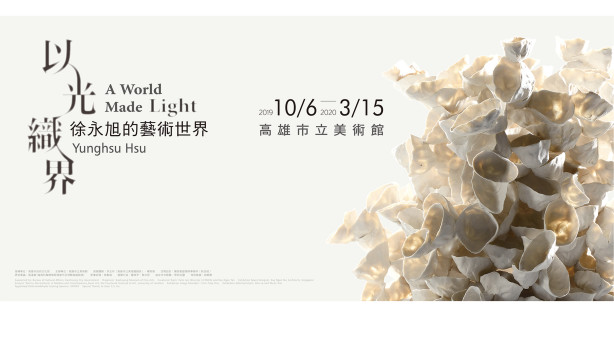A World Made Light- Yunghsu Hsu
2019.10.06(Sun) - 2020.03.15(Sun)
Kaohsiung Museum of Fine Arts 104-105room (No. 80, Meishuguan Rd, Gushan District, Kaohsiung City, 804)
Kaohsiung Museum of Fine Arts
Yulin Lee(Director of KMFA) and Kay Ngee Tan(Kay Ngee Tan Architects,Singapore)
Author: Yulin Lee(Director of KMFA)
About this Exhibition
“The gods had condemned Sisyphus to ceaselessly rolling a rock to the top of a mountain, whence the stone would fall back of its own weight. They had thought with some reason that there is no more dreadful punishment than futile and hopeless labor.” (Albert Camus, The Myth of Sisyphus, 1942)
As an artist born in Kaohsiung, Hsu has a naturally deep connection with KMFA. Back in 1995, he won the 2nd place with his The White Movement—Dancing Together Ⅱ in the handicraft category of the 12th Kaohsiung Fine Arts Exhibition. Even though his winning work reflected his susceptibility back then to the inevitable influences of “ceramic handicraft”, it marked a significant breakthrough for an aspiring artist who established his studio in 1987 to teach himself the art of ceramics.
After his artistic exploration and transformation in 2004 and 2005, he demonstrated his significant transcendence of “ceramic handicraft” and his ambition of contemporary ceramic art with his 2006-3, a two-meter-high work of high-temperature thin ceramics placed in the Sculpture Hall of KMFA during the exhibition, Art of Kaohsiung 2006—Kaohsiung Ceramics: Continuity and Innovation.
In the Forum for Creativity in Art: Theater of Clay—Solo Exhibition of Yunghsu Hsu held at KMFA in 2007, he presented a forest of high-temperature ceramics, inviting viewers to walk into the forest complemented with not only changes of light and shadow but also video installations to reflect his inner thoughts during his artistic creation. Always seeking to push his own limits, he has successfully achieved one breakthrough after another and gradually won extremely high recognition and applause from art professionals at home and abroad.
Hsu’s broad artistic vision and immense drive for artistic creation push him to experiment and innovate with materials to come up with thinner, clearer, and stronger ceramics. With his growing ambition, he uses larger and better-equipped kilns to create works more breath-taking in size and presence. In each stage of his artistic development, we can appreciate his thorough exploration behind his transformation of artistic styles.
With what is called “techniques of the self” by Michel Foucault, a French philosopher, Hsu sets himself free from confusion in artistic creation and has focused instead on creating physically demanding works, tolerating or even enjoying the physical ordeals brought by his ceramic art over these years. The larger works he is creating, the more dedicated he is both physically and mentally. Ranging from individual small-size sculptures to large-size sculptures taller than human height or nearly as tall as buildings with an imposing presence like a theater, Hsu’s works straddle a wide spectrum of variety. However, they are actually connected by one unchanged “commonality”.
This “commonality” is Hsu’s daily labor. The process of his artistic creation is as strenuous with seemingly no promise of reaching the end, much like a Sisyphean task. In the eyes of others, this process is like an excruciating torture but Hsu perseveres in rolling the rock uphill to the peak despite all the endless physical ordeals along the way just like Sisyphus in the eyes of Camus. “That hour like a breathing-space which returns as surely as his suffering, that is the hour of consciousness. At each of those moments when he leaves the heights and gradually sinks toward the lairs of the gods, he is superior to his fate. He is stronger than his rock.” (Camus, 1942)
Because of Hsu’s persistence in creating art with his bare hands, there are always traces of hand kneading left intentionally or unintentionally on the surface of his works. These traces inspire us to imagine the “gestures” of his hands in the process of artistic creation; therefore, we can strongly feel his “presence” when standing in front of his magnificent works as if we were “directly facing” the artist. These traces of hand kneading are as important as the works’ textures. As a result, “light” is an indispensable element for Hsu’s works.
With the flow of light, we can see the traces of his hand movements on the works and the textural changes of clay after going through the refinement of flames. As observed by Dr. Wenny Teo, an art historian, light not only gives shape and form to Hsu’s works but also gives them an illusory sense of visual “lightness” created by his manipulation and reconstruction of the thick, heavy clay. As suggested by the twofold meanings of “light” as a noun and an adjective in the exhibition title, A World Made Light, we hope to demonstrate to viewers the unique “light” and “lightness” in Hsu’s works.
The curatorial team looks forward to shedding “light” for viewers on Hsu’s representative works and series since 2011. Because of his extraordinary persistence in and devotion to artistic creation, he has been able to set one new paradigm after another for the art of ceramics, not only inspiring new imagination about the world of kiln firing but also enabling the artistic energy of southern Taiwan to radiate toward the rest of the world.
Having the opportunity to hold this exhibition, we owe our special gratitude to Mr. Yunghsu Hsu, the artist; Mr. Kay Ngee Tan, Principal of Kay Ngee Tan Architects, Singapore; Dr. Wenny Teo, Lecturer in Modern and Contemporary Asian Art, the Courtauld Institute of Art, University of London; Mr. Sean C. S. Hu, CEO of Hu’s Art Company; Mr. Eng Khuang Chow, Designer at Kay Ngee Tan Architects; and lending collectors for their kind assistance, which is as warm as light, to KMFA. Let there be light and let the light shine!

